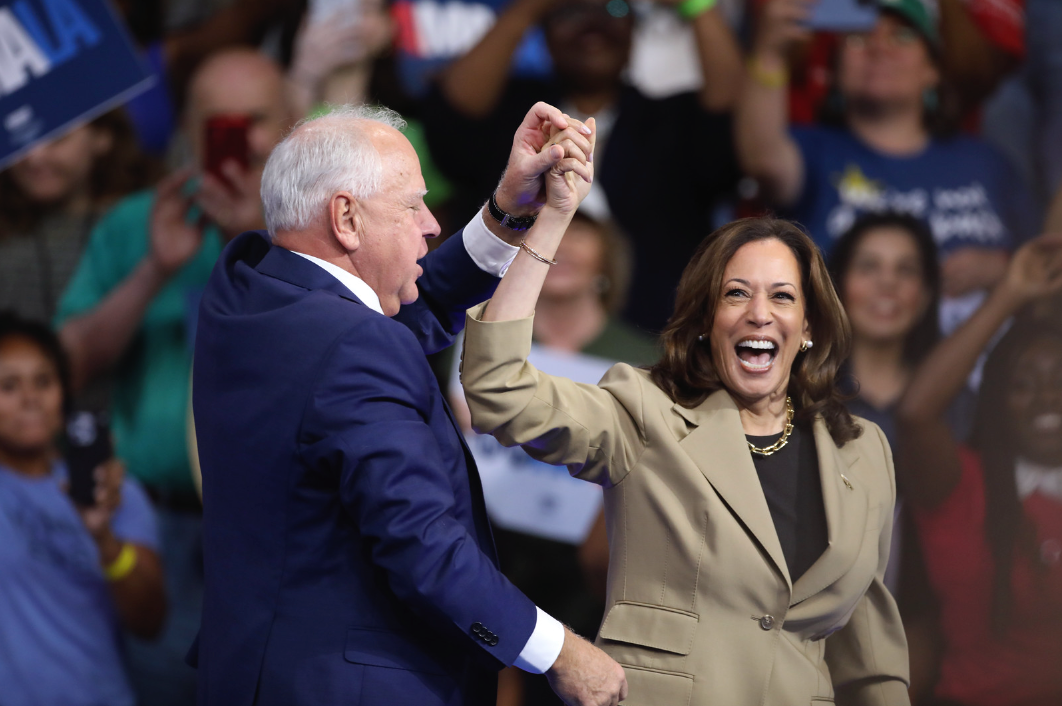A few days before being announced as the running mate of Democrat Kamala Harris, Minnesota Governor Tim Walz made headlines with a phrase he uttered during an interview on MSNBC’s Morning show: “These guys are just weird.” He was referring to the Republican ticket, composed of Donald Trump and JD Vance. The word “weird” ignited social media like a match and revitalized the struggling Democratic campaign, which had been facing setbacks against an apparently unbeatable Trump as the November 5 election approached.
The U.S. electoral race has become perplexing since President Joe Biden stepped down in favor of Vice President Harris. Initially, Harris was not seen as a strong figure. Her lackluster performance and secondary role in political debates seemed to have buried her supposed presidential ambitions.
The rise of Harris
Unexpectedly, polls began to validate the Democratic Convention’s unanimous nomination of Harris. Not only did she unify the party, but she also attracted more resources to the campaign, including contributions from small donors, much like Barack Obama did in his prime.
Since Biden dropped out of the presidential race on July 21, polls have favored Harris over Trump. The difference is just a few percentage points, which could be distorted by the margin of error and the percentage of undecided voters. However, with 77 days until the election, what matters is that she has revived the Democrats’ chances and instilled confidence in the possibility of retaining the White House for another federal term. Even The Washington Post reported that “Harris would be the favorite to win the White House.”
The path ahead is steep, especially in the key battleground states: Arizona, North Carolina, Georgia, Nevada, Michigan, Pennsylvania and Wisconsin. However, winning in these states no longer seems impossible for the Democratic ticket.
Polarized tickets
The campaign has picked up pace and become more captivating. At the same time, it has further exposed cultural divisions and polarization around the fundamental values of the United States, exacerbated by generational differences. At 78 years old, Trump has become the oldest candidate, even in historical terms. Additionally, the running mates, Walz and Vance, contribute to the fragmentation of ideas about identities and the country’s meaning.
It’s true that these divisions were already present in the last two elections. But now, the cultural, social and generational differences between the two candidates are even more pronounced.
With the presidential tickets now in play, it’s worth reviewing their respective electoral profiles and understanding what each represents in a contest that, once again, promises to be very close.
An emboldened Trump
Donald Trump is the same political leader as before, but now he seems more emboldened. It’s likely that his overwhelming victory in the Republican primary and the minimal electoral damage caused by his civil and criminal cases have convinced him that his populist rhetoric will return him to the White House.
He didn’t even use the assassination attempt he suffered during a rally as an excuse to moderate his language, which remains as loquacious as it is offensive. Nor did he call for unity or promote a campaign atmosphere that allows for differences rather than the inflammatory attacks that poison democratic coexistence.
His anti-immigrant rhetoric is louder than ever, portraying undocumented foreigners as a swarm of criminals who will destroy the country. He proposes finishing the wall on the Mexican border and initiating a massive deportation plan for undocumented immigrants, whom he accuses of coming from prisons and mental institutions in Latin America, Africa and Asia and even of being terrorists.
Additionally, in his campaign speeches, he dismisses climate change and multilateral organizations like NATO, which are crucial for the defense of the West.
To this familiar repertoire, he adds harsh criticism of Democrat Biden’s economic policies, blaming him for the price increases that affected the economy due to the economic measures adopted during the COVID-19 pandemic.
The archetype of Vance
JD Vance makes sense as the Republican vice-presidential candidate. This is precisely because of the winning aura Trump exudes, both in his attitude and campaign performance and in how he’s perceived by his supporters.
The 39-year-old Ohio senator was once a Trump critic but has now become his staunchest ally. Ideologically more radical, he is the one who receives a legacy and commits to continuing it in the future.
Vance’s life is a story of overcoming adversity. Born into a single-parent, dysfunctional home in Ohio, he was raised by his maternal grandmother, studied law at Yale University and built a professional career in Silicon Valley before becoming a senator.
His fame came with the 2016 book Hillbilly Elegy, an autobiography about his tough childhood in the Rust Belt, a region encompassing northeastern and midwestern states. This area, once prosperous in the 1970s and 1980s, suffered a decline due to deindustrialization, globalization, foreign competition and automation, which had significant political, economic and social implications.
The book describes the opioid crisis and drug abuse that severely affected families like Vance’s, who were white working-class. In a way, it testifies to the losers of globalization and those who feel resentment over the decline of the industrial development model.
Democrats to the left
Harris seems like a different person since she was freed from the constraints of Biden’s candidacy. Since her name began circulating in July as Biden’s replacement, her hopeful demeanor and rhetoric have sparked interest among some younger voters. She appears to project the future as a 59-year-old candidate who, from a cultural and racial perspective, embodies the diversity of the United States like no one else. Unlike Trump, Harris focuses her discourse on American social plurality, which also garners more support from African American voters.
A lawyer with an extensive background as a prosecutor before becoming a senator and vice president, Kamala Harris is of Indian and African American descent. Her competence gives her confidence in facing the formidable Trump. Additionally, she appears defiant. She knows how to leverage her status as a woman with a multicultural heritage to unsettle Trump, as evidenced by her highlighting the Republican candidate’s hesitations in presidential debates.
Recognizing Harris’s strengths doesn’t mean she’s without vulnerabilities that the opposing party could exploit. One of these is her populist economic agenda. Although well-intentioned, it involves greater state intervention and a deeper increase in public spending, much more profound than the policies implemented by Biden during the pandemic. This proposal could alienate undecided voters, more inclined to abstain, which would harm Democrats at the polls.
Midwestern liberalism
In contrast to Trump’s choice of a running mate, Harris opted for someone who is entirely complementary. Although born in Nebraska, Tim Walz, 60, has built his career in Minnesota. He was a geography teacher, a football coach and had a long career in the National Guard, where he reached the rank of sergeant. This is in addition to his success in politics, having served six terms in the House of Representatives and two terms as governor.
As governor of Minnesota, Walz showcased his version of Midwestern liberalism, in contrast to Vance’s vision. Furthermore, he increased the education budget, expanded the school meals program, created a family leave system (set to take effect in the coming years), legalized marijuana, imposed more controls on gun purchases and strengthened abortion rights.
A weak point that Republicans could exploit is the criticism he received as governor following George Floyd’s death in June 2020, who died due to an improper police procedure.
The truth is that, for now, Walz enjoys great popularity thanks to his straightforward communication style, which appeals to rural Midwestern voters. His approachable, school-teacher demeanor complements Harris’s profile, whom Republicans often stigmatize as a law professor embodying California’s coastal elite.
Chasing the hispanic vote
Given the origins and perspectives of each presidential ticket, it’s still difficult to see which will be more appealing to the nearly 36 million Hispanics eligible to vote.
From what’s been observed in the campaign so far, it seems that the Democrats are making a greater effort than the Republicans to attract these voters. The Democratic Party has taken the lead in Spanish-language advertising and established a WhatsApp communication channel. This makes sense, as it is the party that most needs to mobilize voters to the polls.
In the 2020 election, Biden captured 59% of the Latino vote, with a turnout of just 16.5 million, less than half of those eligible to vote.
Harris’s attributes may be more attractive to Hispanics, even compared to Biden. However, Trump’s anti-illegal immigration rhetoric is also significant. It could appeal to the legal Hispanic workforce, who fears competition from undocumented immigrants.
*Article originally published in Diálogo Político. Translated from the original in Spanish.













